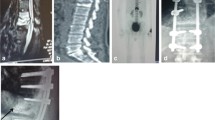Summary
New techniques for internal fixation, employed by neurosurgeons and orthopaedic surgeons, provide reduction and stabilization with early mobilization of patients after injuries of the thoracolumbar spine. It has, however, appeared difficult to prove that the neurological outcome after surgery may be superior to conservative treatment.
In this study the neurological results after surgery are evaluated in 30 patients with injuries of the spinal cord and/or cauda equina. Canal encroachment was found on tomograms or CT in all patients. The unstable fractures, dislocations or fracture-dislocations were all reduced and stabilized by the Harrington distraction device. However, peroperative inspection revealed that the Harrington instrumentation alone may be inadequate in achieving intraspinal decompression. Additional anterior decompression by posterolateral approach was necessary in 13 of the 30 patients (43%). In this series there was an unexpectedly high rate of dural tears. These were found in 8 patients (27%) and nerve roots (cauda equina) appeared to have herniated through the tear in 6 of the 8 patients. Significant improvement of the neurological deficit was obtained in 22 of the 30 patients (73%), and the improvement rate in patients with incomplete lesions of the spinal cord was 83% (25 of 30 patients). In this series there was a definite trend toward greater neurological recovery when compared to the results obtained in patients treated conservatively.
The importance of a neurosurgical approach in diagnosis and treatment of these patients is stressed.
Similar content being viewed by others
References
Bedbrook GM (1975) Treatment of thoracolumbar dislocation and fractures with paraplegia. Clin Orthop 112: 27–43
Bedbrook GM (1979) Spinal injuries with tetraplegia and paraplegia. J Bone Joint Surg 61 B: 267–284
Benassy J, Blanchard J, Lecoq P (1967) Neurological recovery rate in para- and tetraplegia. Paraplegia 4: 259–263
Benzel EC, Larson SJ (1986) Functional recovery after decompressive operation for thoracic and lumbar spine fractures. Neurosurgery 19: 772–778
Bohlman HH (1985) Treatment of fractures and dislocations of the thoracic and lumbar spine. J Bone Joint Surg 67 A: 165–169
Bradford DS, Akbarnia BA, Winter RB, Seljeskog EL (1977) Surgical stabilization of fracture and fracture dislocations of the thoracic spine. Spine 2: 185–196
Bradford DS, Thompson RC (1976) Fractures and dislocations of the spine. Minn Med 58: 711–720
Clark WK (1981) Spinal cord decompression in spinal cord injury. Clin Orthop 154: 9–13
Cotler JM, Vernance JV, Michalski JA (1986) The use of Harrington rods in thoracolumbar fractures. Orthop Clin North Am 17: 87–103
Dickson JH, Harrington PR, Erwin WD (1973) Harrington instrumentation in the fractured, unstable thoracic and lumbar spine. Texas Med 69: 91–98
Dolan EJ, Tator CH, Endrenyi L (1980) The value of decompression for acute experimental spinal cord compression injury. J Neurosurg 53: 749–755
Durward QJ, Schweigel JF, Harrison P (1981) Management of fractures of the thoracolumbar and lumbar spine. Neurosurgery 8: 555–561
Flesch JR, Leider LL, Erickson DL,et al (1977) Harrington instrumentation and spine fusion for unstable fractures and fracture-dislocations of the thoracic and lumbar spine. J Bone Joint Surg (Am) 59 A: 143–153
Frankel HL, Hancock DO, Hyslop G,et al (1979) The value of postural reduction in the initial management of closed injuries of the spine with paraplegia and tetraplegia. Paraplegia 7: 179–192
Garfin SR, Mowery CA, Guerra J, Marshall LF (1985) Confirmation of the posterolateral technique to decompress and fuse thoracolumbar spine burst fractures. Spine 10: 218–223
Guttman L (1973) Spinal cord injuries. Comprehensive management and research. Blackwell Scientific Publications. Oxford
Harrington PR, Dickson JH (1973) The development and further prospects of internal fixation of the spine. Isr J Med Sci 9: 773–778
Jacobs RR, Asher MA, Snider RK (1980) Thoracolumbar spinal injuries. Spine 5: 463–477
Jacobs RR, Casey MP (1984) Surgical management of thoracolumbar spinal injuries. Clin Orthop 189: 22–35
Jelsma RK, Kirsch PT, Jelsma LF,et al (1982) Surgical treatment of thoracolumbar fractures. Surg Neurol 18: 156–166
Jelsma RK, Rice JF, Jelsma LF, Kirsch PT (1982) The demonstration and significans of neural compression after spinal injury. Surg Neurol 18: 79–91
Kobrine AI, Stopak B (1979) Advances in treatment of thoracolumbar injuries. Clin Neurosurg 26: 570–581
Larsen SJ, Holst RA, Hemmy CD, Sances A (1976) Lateral extracavitary approach to traumatic lesions of the thoracic and lumbar spine. J Neurosurg 45: 628–633
Lesoin F, Bouasakao N, Cama A (1982) Posttraumatic fixation of the thoracolumbar spine using Roy-Camille plates. Surg Neurol 18: 167–173
Lewis J, McKibbin B (1974) The treatment of unstable fracturedislocations of the thoracolumbar spine accompanied by paraplegia. J Bone Joint Surg 56 B: 603–612
McAfee PC, Yuan HA, Lasda NA (1982) The unstable burst fracture. Spine 7: 365–373
Miller CA, Dewey RC, Hunt WE (1980) Impaction fracture of the lumbar vertebrae with dural tear. J Neurosurg 53: 765–771
Roy-Camille R, Saillant G, Mazel CH (1986) Plating of thoracic, thoracolumbar and lumbar injuries with pedicle screw plates. Orthop Clin North Am 17: 147–159
Svensson O, Aaro S, Øhlen G (1984) Harrington instrumentation for thoracic and lumbar vertebral fractures. Acta Orthop Scand 55: 38–47
Tarlov IM (1972) Acute spinal cord compression paralysis. J Neurosurg 36: 10–20
Tarlov IM, Klinger H (1954) Spinal cord compression studies. Arch Neurol Psychiat 71: 271–290
Willen J, Lindahl S, Nordwall A (1985) Unstable thoracolumbar fractures. A comparative clinical study of conservative treatment and Harrington instrumentation. Spine 10: 111–122
Yashon D, Bingham GW, Faddoul EM, Hunt WE (1973) Edema of the spinal cord following experimental impact trauma. J Neurosurg 38: 693–697
Yosipovitch Z, Robin GC, Makin M (1977) Open reduction of unstable thoracolumbar spinal injuries and fixation with Harrington rods. J Bone Joint Surg 59 A: 1003–1015
Author information
Authors and Affiliations
Rights and permissions
About this article
Cite this article
Wiberg, J., Hauge, H.N. Neurological outcome after surgery for thoracic and lumbar spine injuries. Acta neurochir 91, 106–112 (1988). https://doi.org/10.1007/BF01424563
Issue Date:
DOI: https://doi.org/10.1007/BF01424563




